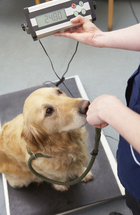Canine Diabetes
 Diabetes, medically known as diabetes mellitus, often occurs in dogs. It results from an insufficient production of insulin by the pancreas. Insulin aids in the digestion of glucose (sugar). Although any dog can become diabetic, some dogs inherit a predisposition to the disorder and some breeds are more susceptible. The disease is three times more common in female dogs than in males and typically develops in dogs between 6 and 9 years of age.
Diabetes, medically known as diabetes mellitus, often occurs in dogs. It results from an insufficient production of insulin by the pancreas. Insulin aids in the digestion of glucose (sugar). Although any dog can become diabetic, some dogs inherit a predisposition to the disorder and some breeds are more susceptible. The disease is three times more common in female dogs than in males and typically develops in dogs between 6 and 9 years of age.
Risk Factors for Canine Diabetes
While the precise cause of canine diabetes remains unknown, some factors are associated with its development. These include:
- Obesity
- Chronic pancreatitis
- Certain medications
Breeds with a genetic predisposition to diabetes include: golden retrievers, Australian terriers, schnauzers, dachshunds, poodles, German shepherds, keeshonds, poodles, and samoyeds.
Symptoms of Canine Diabetes
There are two types of canine diabetes, Type I in which not enough insulin is produced and Type II in which the dog's body does not respond properly to the hormone. Type I, which requires insulin treatment, is by far the more common.
Early Symptoms of Canine Diabetes
When a dog experiences the insulin deficiency that defines diabetes, the result is a high level of glucose in the blood (hyperglycemia) and in the urine. The imbalance between insulin and glucose at first produces the following symptoms:
- Excessive urination
- Excessive thirst
- Change of appetite
- Unexplained weight loss
- Sweet-smelling breath
Dogs with diabetes also have a tendency to develop chronic skin and urinary tract infections.
Later Symptoms of Canine Diabetes
Left untreated, canine diabetes can result in extremely serious symptoms. These may include:
- Vomiting
- Malnutrition
- Dehydration
- Weakness
- Cataract formation, blindness.
If canine diabetes is not properly treated, the resulting severe hyperglycemia can cause diabetic ketoacidosis, a life-threatening complication in which ketones (acids) build up in the blood. Because the diabetic dog cannot digest sugars, the body begins to metabolize fat for energy. Dogs with diabetic ketoacidosis vomit, pant excessively and become very weak. Their breath smells like nail polish remover (acetone). Dogs with diabetic ketoacidosis require emergency veterinary care.
In its last stages, diabetes affects all the organs of the dog's body. Diabetic dogs are more susceptible to bacterial and viral infections and may develop enlarged livers and neurological difficulties. Unless treated, canine diabetes can result in coma and death.
Diagnosis of Canine Diabetes
Canine diabetes is diagnosed through physical examination, reported behavior, blood tests and urinalysis. Prompt diagnosis is crucial because when dogs are given appropriate treatment at an early stage of the disease, they can live comfortably with the disorder.
Treatment of Canine Diabetes
In some cases, canine diabetes can be treated with diet and oral medication alone, but, in most situations, insulin therapy is necessary. Insulin is administered by injection. Doses are prescribed depending on the dog's weight and blood glucose curve, a test that measures the peaks and valleys of blood sugar. The dog owner is taught by the veterinarian how to monitor the dog's glucose level with a test strip and how to administer the appropriate amount of medication.
The diet of a dog with diabetes has to be carefully regulated. This is necessary to keep the animal at a normal weight and to make sure that the dog receives the appropriate dosage of insulin since the dosage is based on caloric intake. It is best to keep diabetic dogs on a consistent regimen with food and insulin injections given at the same time every day. A dog with diabetes should be fed two or three times a day, with its ideal caloric intake divided accordingly.
Dog foods with high fiber content and rich in complex carbohydrates are typically prescribed and dog treats with high sugar content are to be avoided. As much as possible, the dog should get the same amount of exercise each day.
While canine diabetes is a serious condition, with appropriate diet and insulin therapy diabetic dogs can live happy, active lives.
